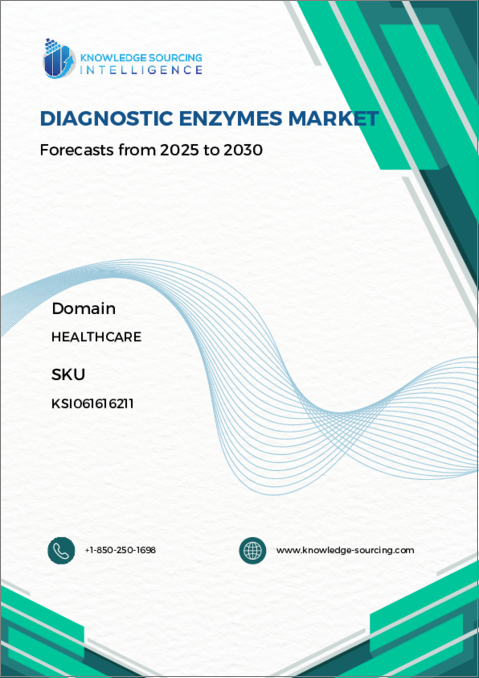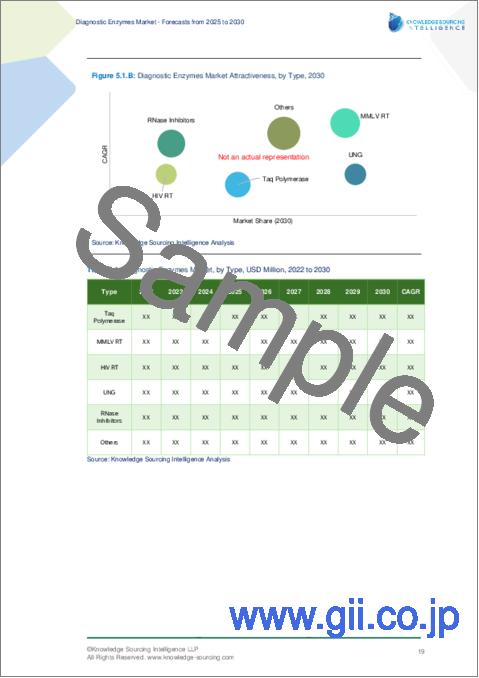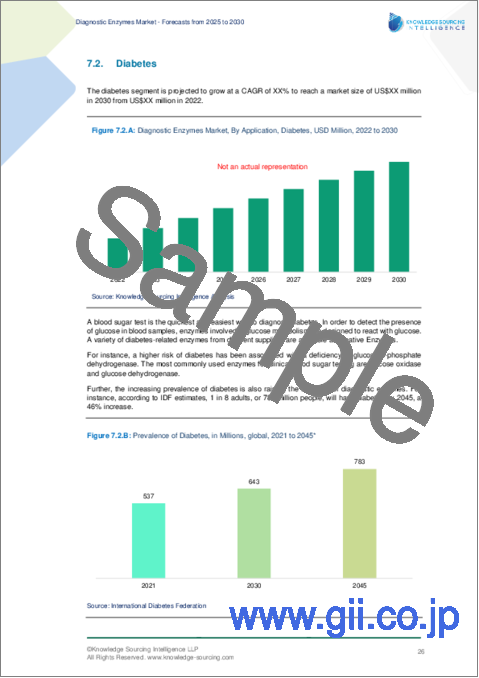|
|
市場調査レポート
商品コード
1425116
診断用酵素の世界市場:予測(2024年~2029年)Diagnostic Enzymes Market - Forecasts from 2024 to 2029 |
||||||
カスタマイズ可能
|
|||||||
| 診断用酵素の世界市場:予測(2024年~2029年) |
|
出版日: 2024年01月24日
発行: Knowledge Sourcing Intelligence
ページ情報: 英文 147 Pages
納期: 即日から翌営業日
|
全表示
- 概要
- 目次
世界の診断用酵素の市場規模は、2022年に46億4,600万米ドルと評価されました。
生物学的異常を特定・分析するために酵素を用いるという概念は、内因性酵素の活性が健康に敏感であるという事実に基づいています。加えて、生理的異常の兆候でもある基質濃度の変動は、酵素によって検出することができます。例えば、コレステロールオキシダーゼを使ってコレステロールを測定すれば、心血管系の問題や高血圧の可能性が特定できるかもしれません。バイオテクノロジーでは、酵素は酵素結合免疫吸着測定法(ELISA)や結合マルチ酵素反応アッセイのような分析・検出技術を開発するために採用されることがあります。
高齢者人口の増加
診断用酵素市場は、高齢化によってさらに急速に拡大すると予想されます。世界保健機関(WHO)によれば、2030年までに6人に1人が60歳以上の高齢者となり、その主な原因は新興国にあります。2020年~2050年の間に、80歳以上の人口は3倍に増加し、4億2,600万人に達すると予測されています。高齢者は通常、難聴、白内障、屈折異常、背中や首の痛み、変形性関節症、糖尿病、うつ病、認知症などを患っており、これがジェネリック医薬品の使用量増加の一因となっています。高齢になると、一度に複数の病気にかかりやすくなるため、診断用酵素市場の成長に拍車がかかる可能性があります。
糖尿病診断のための診断用酵素
糖尿病を特定する最も迅速で簡単な方法は血糖値検査です。グルコースの代謝に関与する酵素は、グルコースと反応するように作られ、その結果、血液サンプル中のグルコースの存在を検出します。Creative Enzymesでは、様々なサプライヤーから糖尿病関連酵素を幅広く取り扱っています。例えば、グルコース-6-リン酸デヒドロゲナーゼの欠乏は、糖尿病の発症リスクの増加と関連しています。臨床血糖検査では、グルコースオキシダーゼとグルコースデヒドロゲナーゼが最も頻繁に利用されています。グルコースの使用を開始するには、ヘキソキナーゼがグルコースのリン酸化を触媒してグルコース6-リン酸を生成します。
肝機能検査の診断用酵素
肝機能障害の治療や肝疾患の早期発見は、肝機能検査の結果によって左右されます。様々な肝障害や肝疾患に関連する奇妙な化合物の存在を特定するために、様々な酵素反応が生み出され、診断用酵素産業を後押ししています。例えば、Creative Enzymesは診断用酵素製品で、肝機能評価の臨床的・科学的利用をサポートしています。この事業には、消費者の特別なニーズを満たすために、様々な天然源または生化学的合成からいくつかの肝機能関連酵素が含まれています。リンゴ酸デヒドロゲナーゼ、D-乳酸デヒドロゲナーゼ、アルコールデヒドロゲナーゼ、アルカリホスファターゼはすべて、天然または組換えの形で入手可能です。
ヌクレアーゼ酵素の需要の高まり
ヌクレアーゼと呼ばれる酵素は、DNAやRNAのヌクレオチド鎖を細かく分割します。DNA分子はヌクレアーゼ酵素によって分解され、DNA鎖中のヌクレオチド同士をつなぐホスホジエステル結合も分解されます。エキソヌクレアーゼとエンドヌクレアーゼは、2つの異なる種類のヌクレアーゼです。さらに、2023年3月には、酵素の専門家であるBiocatalysts Ltdから、様々な供給源から様々な核酸を分解するための新規酵素であるNuclease 46L(N046L)が発売されました。この酵素は主に、様々なバイオテクノロジー用途でDNAを除去するための低コストな方法として開発されました。このような開発は、診断用酵素産業の発展に不可欠です。
北米では、診断用酵素市場は着実に成長すると予測されています。
北米では、酵素の需要が拡大し、感染症が蔓延していることから、主導的な地位を占めると予想されています。例えば、FDAはCOVID-19実験室開発診断薬を緊急時に使用することを認可し、現在進行中の感染症流行に対処しています。SARS-CoV-2の検出のために、これらの緊急使用認可の大部分は、RT-PCRベースの検査と酵素結合免疫吸着検査も採用しています。RT-PCRは多くの酵素を使用するため、北米の診断用酵素市場ではこのようなアッセイの開発が利益を生むと予測されています。
診断用酵素に対する政府の取り組み
- 国家保健ミッション(National Health Mission)に従い、州や都は、プログラム実施計画(Programme Implementation Plan:PIPs)や全体的な資源枠に記載された要求に従って、公的医療施設において基本的な医薬品を無料で提供するための財政援助を受けています。必要な医薬品への普遍的なアクセスを保証するため、同省は、公共医療機関で施設別の必須医薬品リスト(EDL)にアクセスできるようにすることを提案しています。
- 迅速診断検査(RDT)は、感染性生物を迅速かつ正確に同定し、各種抗生物質に対する感受性を判定する上で大きな可能性を秘めています。そのため、将来的には抗菌薬管理(AMS)プログラムにおいて大きな役割を果たすと期待されています。RDTの使用は、いくつかの特定の状況におけるAMSの展開のための国際標準によってすでに奨励されています。
診断用酵素製品
- EKF Diagnostics:診断用酵素はEKF Life Sciencesによって製造され、臨床診断試薬として利用されています。サリチル酸ヒドロキシラーゼ、β-ヒドロキシ酪酸デヒドロゲナーゼ、アリールアシルアミダーゼなどがあります。これらの診断用酵素は、「スタンバイオケミストリー」ブランドとして、臨床診断薬メーカー各社の試薬やOEM試薬の製造用として市販されています。
- 旭化成ファーマ:糖尿病合併症を防ぐためには、血糖値を適切にコントロールすることが重要です。糖化アルブミンは、採血前2週間の平均血糖値を測定します。糖化アルブミンは、2004年に発売されたルシカTM GA-L液体試薬検査キットを用いて測定します。糖化アルブミンは、2009年に日本赤十字社から献血血液の検査項目として採用されました。
目次
第1章 イントロダクション
- 市場概要
- 市場の定義
- 調査範囲
- 市場セグメンテーション
- 通貨
- 前提条件
- 基準年と予測年のタイムライン
第2章 調査手法
- 調査データ
- 前提条件
第3章 エグゼクティブサマリー
- 調査ハイライト
第4章 市場力学
- 市場促進要因
- 市場抑制要因
- ポーターのファイブフォース分析
- 業界バリューチェーン分析
第5章 診断用酵素市場:タイプ別
- イントロダクション
- Taqポリメラーゼ
- MMLV RT
- HIV RT
- NG
- RNase阻害剤
- その他
第6章 診断用酵素市場:製品タイプ別
- イントロダクション
- 分子酵素
- 臨床用酵素
第7章 診断用酵素市場:用途別
- イントロダクション
- 糖尿病
- 腫瘍学
- 心臓病学
- 感染症
- その他
第8章 診断用酵素市場:地域別
- イントロダクション
- 北米
- 米国
- カナダ
- メキシコ
- 南米
- ブラジル
- アルゼンチン
- その他
- 欧州
- 英国
- ドイツ
- フランス
- スペイン
- その他
- 中東・アフリカ
- サウジアラビア
- アラブ首長国連邦
- イスラエル
- その他
- アジア太平洋
- 日本
- 中国
- インド
- 韓国
- インドネシア
- タイ
- その他
第9章 競合環境と分析
- 主要企業と戦略分析
- 市場シェア分析
- 合併・買収・協定・協業
- ベンダー競争力マトリックス
第10章 企業プロファイル
- EKF Diagnostics
- Sekisui Diagnostics
- Negen Corporation
- Novozymes
- CustomBiotech
- TOYOBO
- Asahi Kasei
- Sekisui Medical Co. Ltd.
- NZYTech
- Megazyme
The diagnostic enzymes market was valued at US$4.646 billion in 2022.
The notion of employing enzymes to identify and analyze biological abnormalities is based on the fact that the activity of endogenous enzymes is sensitive to health. In addition, variations in the concentration of the substrate, which are also a sign of physiological abnormalities, can be detected by enzymes. For instance, measuring cholesterol using cholesterol oxidase might identify probable cardiovascular problems or high blood pressure. In biotechnologies, enzymes may be employed to create analysis and detection techniques like the enzyme-linked immunosorbent assay (ELISA) and coupled multi-enzyme reaction assays.
Increase in geriatric population
The diagnostic enzymes market is expected to expand more quickly as a result of the aging population. By 2030, 1 in 6 individuals will be 60 or older, with emerging countries being primarily responsible for this growth, according to the World Health Organisation. Between 2020 and 2050, the number of persons 80 or older is projected to treble, reaching 426 million. Elderly patients typically have hearing loss, cataracts and refractive errors, back and neck pain and osteoarthritis, diabetes, depression, and dementia, which contributes to the rising usage of generic medications. People are more prone to several diseases at once as they get older which can fuel the growth of the diagnostic enzymes market.
Diagnostic Enzymes for Diabetes Diagnosis
The quickest and easiest way to identify diabetes is with a blood sugar test. Enzymes involved in the metabolism of glucose are created to react with glucose and, as a result, to detect the presence of glucose in blood samples. Creative Enzymes carries a wide range of diabetes-related enzymes from various suppliers. For instance, a lack of glucose-6-phosphate dehydrogenase has been linked to an increased risk of developing diabetes. For clinical blood sugar tests, glucose oxidase and glucose dehydrogenase are most frequently utilized. To start using glucose, hexokinase catalyzes the phosphorylation of glucose to produce glucose 6-phosphate.
Diagnostic enzymes for liver function test
The therapy of individuals with hepatic dysfunction and early detection of liver illnesses depend on the results of liver function tests. To identify the presence of odd compounds linked to various forms of liver injury or disorders, a variety of enzymatic reactions are created which boosts the diagnostic enzymes industry. For instance, with their diagnostic enzyme products, Creative Enzymes has supported the clinical and scientific usage of liver function assessment. The business includes several liver function-related enzymes from various natural sources or biochemical syntheses to satisfy the unique requirements of the consumer. Malate dehydrogenase, D-lactate dehydrogenase, alcohol dehydrogenase, and alkaline phosphatase are all available in either natural or recombinant forms.
Rising demand for nuclease enzymes
An enzyme called nuclease divides the DNA and RNA nucleotide chain into smaller pieces. The DNA molecule is broken down by the nuclease enzyme, as well as the phosphodiester bonds connecting one nucleotide to another in the DNA strand. Exonucleases and endonucleases are the two distinct kinds of nucleases. Additionally, in March 2023, Nuclease 46L (N046L), a novel enzyme from enzyme experts Biocatalysts Ltd, is now available for the breakdown of various nucleic acids from a variety of sources. It was created primarily as a low-cost method to get rid of DNA in a variety of biotechnology applications. These developments are essential for the development of the diagnostic enzymes industry.
In North America, it is projected that the diagnostic enzymes market will grow steadily.
North American region is expected to take a leading position as a result of the expanding demand for enzymes and the prevalence of infectious illnesses there. For instance, the FDA has authorized COVID-19 laboratory-developed diagnostics for use in emergencies to tackle the ongoing outbreak. For the detection of SARS-CoV-2, the majority of these emergency usage authorizations also employ RT-PCR-based testing and enzyme-linked immunosorbent tests. Because RT-PCR uses a lot of enzymes, the development of such assays is projected to be profitable in the North American diagnostic enzymes market.
Government initiatives for diagnostic enzymes
- Following the National Health Mission, States and UTs get financial assistance to offer free basic medications in public health facilities following the demands stated in their Programme Implementation Plans (PIPs) and the overall resource envelope. To guarantee universal access to necessary medications, the ministry has proposed that a facility-specific Essential Drugs List (EDL) be made accessible at public healthcare institutions.
- Rapid diagnostic tests (RDTs) have a great deal of potential for quickly and accurately identifying infectious organisms and determining their susceptibility to various types of antibiotics. As a result, they are expected to play a bigger role in antimicrobial stewardship (AMS) programs in the future. RDT usage is already encouraged by international standards for the deployment of AMS in a few particular contexts.
Diagnostic enzymes Products
- EKF Diagnostics, Diagnostic enzymes are produced by EKF Life Sciences and utilised as clinical diagnostic reagents. Among these are salicylate hydroxylase, beta-hydroxybutyrate dehydrogenase, and arylacylamidase. These diagnostic enzymes are sold commercially for use in the manufacturing of third-party clinical diagnostic firms' reagents as well as OEM reagents under the Stanbio Chemistry brand.
- Asahi Kasei Pharma, Controlling blood sugar properly is crucial for avoiding diabetic complications. The glycated albumin measures the average glycemia throughout the two weeks before the blood sample. Glycated albumin is measured using the LucicaTM GA-L liquid reagent test kit, which was introduced in 2004. Glycated albumin was included as a laboratory test component for donated blood by the Japan Red Cross in 2009.
Market Key Developments
- In June 2023, scientists from the Indian Institute of Science created a fluorogenic probe to identify an enzyme associated with the early stages of the neurodegenerative illness Alzheimer's.
- In February 2023, a pioneer in the production and delivery of diagnostic enzymes, Creative Enzymes, and research diagnostics. The company recently included pancreatic and kidney enzymes.
- In December 2022, Ginkgo Enzyme Services was launched, according to Ginkgo Bioworks, which is developing the top platform for cell programming and biosecurity. Ginkgo Enzyme Services is supported by optimized, patented bacterial and fungal host strains, machine learning-guided protein design, and ultra-high throughput screening.
Segmentation:
By Type
- Taq Polymerase
- MMLV RT
- HIV RT
- UNG
- RNase Inhibitors
- Others
By Product Type
- Molecular Enzymes
- Clinical Enzymes
By Application
- Diabetes
- Oncology
- Cardiology
- Infectious Diseases
- Others
By Geography
- North America
- United States
- Canada
- Mexico
- South America
- Brazil
- Argentina
- Others
- Europe
- United Kingdom
- Germany
- France
- Spain
- Others
- Middle East and Africa
- Saudi Arabia
- UAE
- Israel
- Others
- Asia Pacific
- Japan
- China
- India
- South Korea
- Indonesia
- Thailand
- Others
TABLE OF CONTENTS
1. INTRODUCTION
- 1.1. Market Overview
- 1.2. Market Definition
- 1.3. Scope of the Study
- 1.4. Market Segmentation
- 1.5. Currency
- 1.6. Assumptions
- 1.7. Base, and Forecast Years Timeline
2. RESEARCH METHODOLOGY
- 2.1. Research Data
- 2.2. Assumptions
3. EXECUTIVE SUMMARY
- 3.1. Research Highlights
4. MARKET DYNAMICS
- 4.1. Market Drivers
- 4.2. Market Restraints
- 4.3. Porter's Five Force Analysis
- 4.3.1. Bargaining Power of Suppliers
- 4.3.2. Bargaining Power of Buyers
- 4.3.3. Threat of New Entrants
- 4.3.4. Threat of Substitutes
- 4.3.5. Competitive Rivalry in the Industry
- 4.4. Industry Value Chain Analysis
5. DIAGNOSTIC ENZYMES MARKET, BY TYPE
- 5.1. Introduction
- 5.2. Taq Polymerase
- 5.3. MMLV RT
- 5.4. HIV RT
- 5.5. UNG
- 5.6. RNase Inhibitors
- 5.7. Others
6. DIAGNOSTIC ENZYMES MARKET, BY PRODUCT TYPE
- 6.1. Introduction
- 6.2. Molecular Enzymes
- 6.3. Clinical Enzymes
7. DIAGNOSTIC ENZYMES MARKET, BY APPLICATION
- 7.1. Introduction
- 7.2. Diabetes
- 7.3. Oncology
- 7.4. Cardiology
- 7.5. Infectious Diseases
- 7.6. Others
8. DIAGNOSTIC ENZYMES MARKET, BY GEOGRAPHY
- 8.1. Introduction
- 8.2. North America
- 8.2.1. United States
- 8.2.2. Canada
- 8.2.3. Mexico
- 8.3. South America
- 8.3.1. Brazil
- 8.3.2. Argentina
- 8.3.3. Others
- 8.4. Europe
- 8.4.1. United Kingdom
- 8.4.2. Germany
- 8.4.3. France
- 8.4.4. Spain
- 8.4.5. Others
- 8.5. The Middle East and Africa
- 8.5.1. Saudi Arabia
- 8.5.2. UAE
- 8.5.3. Israel
- 8.5.4. Others
- 8.6. Asia Pacific
- 8.6.1. Japan
- 8.6.2. China
- 8.6.3. India
- 8.6.4. South Korea
- 8.6.5. Indonesia
- 8.6.6. Thailand
- 8.6.7. Others
9. COMPETITIVE ENVIRONMENT AND ANALYSIS
- 9.1. Major Players and Strategy Analysis
- 9.2. Market Share Analysis
- 9.3. Mergers, Acquisitions, Agreements, and Collaborations
- 9.4. Vendor Competitiveness Matrix
10. COMPANY PROFILES
- 10.1. EKF Diagnostics
- 10.2. Sekisui Diagnostics
- 10.3. Negen Corporation
- 10.4. Novozymes
- 10.5. CustomBiotech
- 10.6. TOYOBO
- 10.7. Asahi Kasei
- 10.8. Sekisui Medical Co. Ltd.
- 10.9. NZYTech
- 10.10. Megazyme





